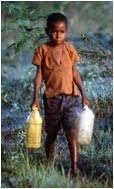United Nations University, Tokyo
18 March 1999
 Clean, safe water can be brought to the 1.4 billion people around the world without it for as little as $50 per person, which can prevent many of the 3.35 billion cases of illness and 5.3 million deaths caused each year by unsafe water, says a United Nations analysis.
Clean, safe water can be brought to the 1.4 billion people around the world without it for as little as $50 per person, which can prevent many of the 3.35 billion cases of illness and 5.3 million deaths caused each year by unsafe water, says a United Nations analysis.
At any given time, an estimated one half of people in developing countries are suffering from diseases caused either directly by infection through the consumption of contaminated water or food, or indirectly by disease carrying organisms (vectors), such as mosquitoes, that breed in water. These diseases include diarrhea, schistosomiasis, dengue fever, infection by intestinal worms, malaria, river blindness (onchocerciasis) and trachoma (which alone causes almost six million cases of blindness or severe complications annually).
The UN warns that unless action is stepped up, the number of people without access to safe water will increase to 2.3 billion by 2025, with the number of those who die from unsafe water expected to jump sharply as well.
Right now, 20 percent of the world’s population in 30 countries face water shortages, a figure that will rise to 30 percent of the world’s population, in 50 countries, by 2025, according to the UN, observing World Day for Water on March 22. The theme of World Water Day 1999 is: “Everyone lives downstream,” meant to convey that problems in one part of a watershed, or even in a country abroad, can affect people great distances away.
“Driven by a rising global standard of living and increasing food production, water demand is increasing at twice the population growth rate,” says Hans van Ginkel, Rector of the UN University (UNU), an international community of scholars engaged in research, training and knowledge dissemination to promote the UN’s aims of peace and progress.
News release in full, click here
Example coverage:
Financial Times (front page), click here
Reuters, click here
Newsweek, click here
Toronto Sun, click here
Coverage summary, click here